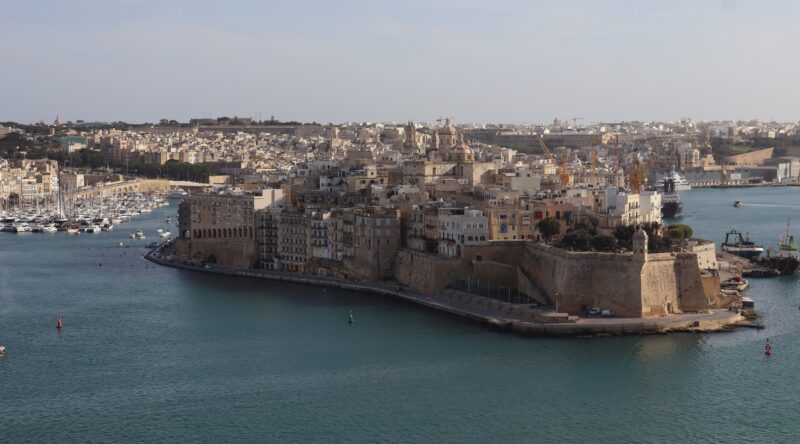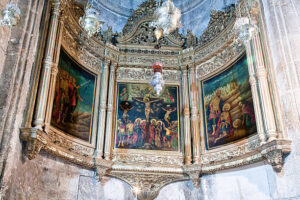My Regensburg Year Part 7: February 2025
The days are short now in Regensburg, and there is less activity on the streets. The only festivity to break up the routine is the eating of Krapfen (donuts) to celebrate Karneval or Fasching. The surge of sugar makes everything more bearable. But if you need something more to get through the Winter, you can also just . . . escape. So we headed to Malta.
There’s something comforting about Malta. The language is a combination of Arabic and Italian but plenty of English is spoken. The English influence is seen also in the traffic, with driving on the left, the red phone booths and post boxes, and the three-pronged electrical plugs. I felt surprisingly at home there. It is a land of forts, each one telling stories of the battles fought from their high walls. It’s also friendly, lively, and . . . cheap! I know we were there in the off-season, but the cost of our accommodations was a steal—and not because I booked us at an Ibis near the airport (we were quiet close to Valetta in a cosy boutique hotel). A bus ride anywhere on the island is a measly 2 Euro. And I was particularly chuffed at the 1.50 tea in the picturesque Upper Barrakka Gardens. We were delighted also in watching the feral cats taken care of by the city. We first encountered this practice in Cordoba, so it was no big surprise. But we were a bit perplexed about the free range chickens that we saw darting around.
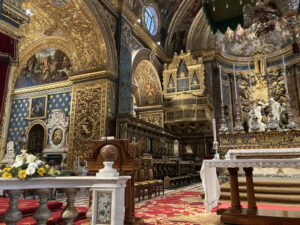 Among the highlights of our time in Valletta was a visit to the St. John Co-cathedral. Built in the sixteenth century in honor of John the Baptist, the cathedral is lavishly decorated in gold-painted stucco designs, and frescoes depicting episodes from the life of John cover the ceiling. One of these images is described in a guide as “St. John handing a coin to a soldier.” I am not aware of this tale from any apocryphal account of the Baptist. It made me recall, however, a Syriac manuscript from Malta said to contain a Life of John the Baptist. Slavomír Céplö and I tried for a few years to get access to the manuscript. When it was finally made available on HMML, its description was revised—it is said now to contain a metrical grammar by Bar Hebraeus. Still, I was sure I was sent scans of the manuscript and it did indeed contain an account of John (something I will have to check on when I return home).
Among the highlights of our time in Valletta was a visit to the St. John Co-cathedral. Built in the sixteenth century in honor of John the Baptist, the cathedral is lavishly decorated in gold-painted stucco designs, and frescoes depicting episodes from the life of John cover the ceiling. One of these images is described in a guide as “St. John handing a coin to a soldier.” I am not aware of this tale from any apocryphal account of the Baptist. It made me recall, however, a Syriac manuscript from Malta said to contain a Life of John the Baptist. Slavomír Céplö and I tried for a few years to get access to the manuscript. When it was finally made available on HMML, its description was revised—it is said now to contain a metrical grammar by Bar Hebraeus. Still, I was sure I was sent scans of the manuscript and it did indeed contain an account of John (something I will have to check on when I return home).
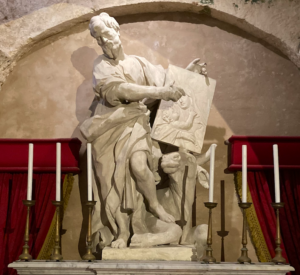 One of our days was spent outside Valletta in Mdina and neighboring Rabat. Of particular interest in Rabat are St. Paul’s Catacombs, a necropolis used between the third and eighth centuries. Adjacent to the catacombs is St. Paul’s Grotto, said to be where Paul was imprisoned during his stay on the island (as documented in Acts 28:1–10, though here Paul stays at the estate of the chief official named Publius). The only apocryphal iconography in the grotto was a statue of Luke holding a painting of the Virgin and child. This is a very common depiction of Luke and relates to the tradition that he was the first icon painter.
One of our days was spent outside Valletta in Mdina and neighboring Rabat. Of particular interest in Rabat are St. Paul’s Catacombs, a necropolis used between the third and eighth centuries. Adjacent to the catacombs is St. Paul’s Grotto, said to be where Paul was imprisoned during his stay on the island (as documented in Acts 28:1–10, though here Paul stays at the estate of the chief official named Publius). The only apocryphal iconography in the grotto was a statue of Luke holding a painting of the Virgin and child. This is a very common depiction of Luke and relates to the tradition that he was the first icon painter.

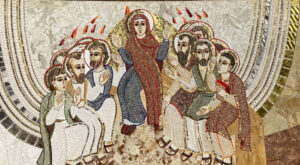 Another day was spent on the nearby island of Gozo. A hop-on/hop-off bus took us around the major sites, including the Cittadella of Victoria. On the grounds of this castle is the Cathedral of the Assumption which houses a statue of Mary standing upon clouds. The statue, created in Rome in 1897, is taken out every year on the 15th of August and paraded around the streets with great pomp before making its way back to the cathedral. Five km away is the Basilica of the National Shrine of the Blessed Virgin of Ta’Pinu. The entrance is decorated with a series of modern mosaics (created in 1932) depicting the life of Mary; two of the mosaics are based on the assumption (a scene of the apostles at the death bed of Mary and another of Mary on her way to heaven). Our trip to Gozo was capped off by a small misadventure: we accidentally took the wrong ferry back to Malta, ending up on the western tip of the island, not the eastern. Fortunately, the island is only 27km across, so a short cab ride brought us back to our hotel.
Another day was spent on the nearby island of Gozo. A hop-on/hop-off bus took us around the major sites, including the Cittadella of Victoria. On the grounds of this castle is the Cathedral of the Assumption which houses a statue of Mary standing upon clouds. The statue, created in Rome in 1897, is taken out every year on the 15th of August and paraded around the streets with great pomp before making its way back to the cathedral. Five km away is the Basilica of the National Shrine of the Blessed Virgin of Ta’Pinu. The entrance is decorated with a series of modern mosaics (created in 1932) depicting the life of Mary; two of the mosaics are based on the assumption (a scene of the apostles at the death bed of Mary and another of Mary on her way to heaven). Our trip to Gozo was capped off by a small misadventure: we accidentally took the wrong ferry back to Malta, ending up on the western tip of the island, not the eastern. Fortunately, the island is only 27km across, so a short cab ride brought us back to our hotel.
In other news this month, on February 5 I was invited to the University of Erlangen-Nuremberg for a presentation on the Infancy Gospel of Thomas to the class of Prof. Christina Eschner. I formally announced the creation of the Apocrypha of Symeon Metaphrastes Project (mentioned in my last post) with a page dedicated to the project on my web site. And, of course, I continued plugging away at my AYBRL Christian apocrypha volume. I am still suffering through my survey of Passion materials, completing a section on traditions of Longinus the Centurion and moving on to the Gospel of Judas—a difficult task given how much has been written about this gospel in the short time since its discovery. The Longinus texts, however, I enjoyed because they are so little known; of the four texts, only two have appeared in a modern translation (French), and they have never been included in apocrypha compendia.
There are actually two centurions named Longinus: the soldier who pierced Jesus with a spear (celebrated in the West, but likely the earliest tradition given that Longinus derives from the Greek word for spear) and the soldier at the cross who declared Jesus to be the Son of God (in the East). Sometimes the two men are conflated as in the Latin Passion of Longinus, in which the centurion is decapitated in Cappadocia by the prefect Octavius. In the Greek Martyrdom of Longinus attributed to Hesychius of Jerusalem (adapted by Symeon Metaphrastes and expanded into the Encomium on Longinus), no mention is made of the spear. Longinus makes his declaration at the cross and because of his refusal to say the apostles stole Jesus’ body, he abandons his military career and returns to his hometown in Cappadocia. Eventually he is pursued by Pilate’s soldiers and his head is brought back to Jerusalem. Longinus appears to a widow, promising her healing if she returns his head to his body. The Encomium expands on this story, introducing Longinus as a soldier serving under Herod the Great. He is charged to accompany the Magi and becomes a believer in Jesus after a “road to Damascus” moment on his way to Bethlehem. When he refuses to reveal the location of the newborn king, he is imprisoned and tortured by Herod. Later he is tasked by Pilate to bring Jesus to Golgotha, where he makes his declaration of Jesus’ divinity and witnesses the resurrection at the tomb. Other details added to his martyrdom include expansions on the story of the widow: she is given a name (Chrestes) and after she reunites Longinus’ head with his body, she becomes a deaconess, spending her days at Longinus’ oratory, praying and healing.
The soldier with the spear appears frequently in art and iconography, but only when his image is labelled as “Longinus” is he connected to apocryphal traditions. Incidentally, the soldier who gives Jesus the vinegar on a reed also receives a name: Stephaton or Esopos (after hyssop, named by John as the wood of the reed). One of the most interesting depictions of Longinus is found in the Chapel of Longinus in the Church of the Holy Sepulchre. The chapel contains an altar inscribed with the phrase “Now the centurion and those with him saw the things that took place” (Matt 27:54) set before a triptych with two images of Longinus flanking a crucifixion scene: one of Longinus standing with other soldiers and holding a spear, the other a depiction of his decapitation. Longinus also appears in an account of his death appended to the Epistle of Herod to Pilate. Here he is identified as the soldier who pierced Jesus with a spear. For this villainy, he was taken by an angel to a cave across the Jordan where, like Prometheus and the liver-devouring eagle, he is attacked every night by a lion and then made whole again. He will be so punished until Christ’s return.
When next I write, I hope to have moved on to the final chapter on the life of Jesus: Discourses of the Living Jesus, which covers a range of post-resurrection dialogues and apocalypses. Along the way I will be travelling to Switzerland (where I will ascend Mount Pilatus) and Glasgow (where I will do another presentation on the Infancy Gospel of Thomas).

